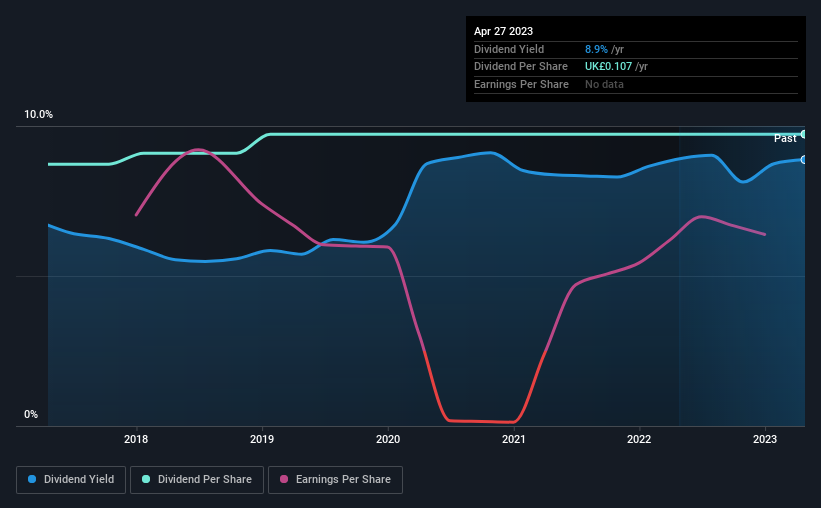
EJF Investments Limited (LON:EJFI) has announced that it will pay a dividend of £0.0268 per share on the 31st of May. Based on this payment, the dividend yield on the company's stock will be 8.9%, which is an attractive boost to shareholder returns.
Check out our latest analysis for EJF Investments
EJF Investments' Payment Has Solid Earnings Coverage
A big dividend yield for a few years doesn't mean much if it can't be sustained. Based on the last payment, EJF Investments was quite comfortably earning enough to cover the dividend. This indicates that quite a large proportion of earnings is being invested back into the business.
Looking forward, EPS could fall by 3.0% if the company can't turn things around from the last few years. If the dividend continues along recent trends, we estimate the payout ratio could be 49%, which we consider to be quite comfortable, with most of the company's earnings left over to grow the business in the future.

EJF Investments Is Still Building Its Track Record
It is great to see that EJF Investments has been paying a stable dividend for a number of years now, however we want to be a bit cautious about whether this will remain true through a full economic cycle. The annual payment during the last 6 years was £0.096 in 2017, and the most recent fiscal year payment was £0.107. This works out to be a compound annual growth rate (CAGR) of approximately 1.8% a year over that time. We like that the dividend hasn't been shrinking. However we're conscious that the company hasn't got an overly long track record of dividend payments yet, which makes us wary of relying on its dividend income.
Dividend Growth May Be Hard To Achieve
Investors who have held shares in the company for the past few years will be happy with the dividend income they have received. However, things aren't all that rosy. In the last five years, EJF Investments' earnings per share has shrunk at approximately 3.0% per annum. Declining earnings will inevitably lead to the company paying a lower dividend in line with lower profits.
Our Thoughts On EJF Investments' Dividend
In summary, while it's good to see that the dividend hasn't been cut, we are a bit cautious about EJF Investments' payments, as there could be some issues with sustaining them into the future. The payments haven't been particularly stable and we don't see huge growth potential, but with the dividend well covered by cash flows it could prove to be reliable over the short term. This company is not in the top tier of income providing stocks.
Market movements attest to how highly valued a consistent dividend policy is compared to one which is more unpredictable. Meanwhile, despite the importance of dividend payments, they are not the only factors our readers should know when assessing a company. For example, we've identified 3 warning signs for EJF Investments (1 makes us a bit uncomfortable!) that you should be aware of before investing. Looking for more high-yielding dividend ideas? Try our collection of strong dividend payers.
If you're looking to trade EJF Investments, open an account with the lowest-cost platform trusted by professionals, Interactive Brokers.
With clients in over 200 countries and territories, and access to 160 markets, IBKR lets you trade stocks, options, futures, forex, bonds and funds from a single integrated account.
Enjoy no hidden fees, no account minimums, and FX conversion rates as low as 0.03%, far better than what most brokers offer.
Sponsored ContentValuation is complex, but we're here to simplify it.
Discover if EJF Investments might be undervalued or overvalued with our detailed analysis, featuring fair value estimates, potential risks, dividends, insider trades, and its financial condition.
Access Free AnalysisHave feedback on this article? Concerned about the content? Get in touch with us directly. Alternatively, email editorial-team (at) simplywallst.com.
This article by Simply Wall St is general in nature. We provide commentary based on historical data and analyst forecasts only using an unbiased methodology and our articles are not intended to be financial advice. It does not constitute a recommendation to buy or sell any stock, and does not take account of your objectives, or your financial situation. We aim to bring you long-term focused analysis driven by fundamental data. Note that our analysis may not factor in the latest price-sensitive company announcements or qualitative material. Simply Wall St has no position in any stocks mentioned.
About LSE:EJFI
Good value with adequate balance sheet.
Market Insights
Community Narratives




